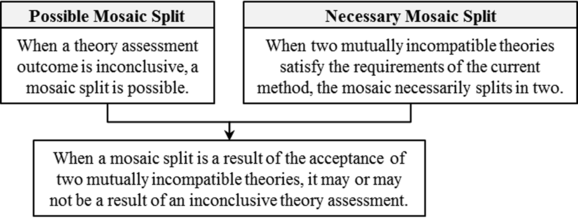Difference between revisions of "Split Due to Inconclusiveness theorem (Barseghyan-2015) Reason1"
Izzy Friesen (talk | contribs) (Created page with "{{Reason |Conclusion=Split Due to Inconclusiveness theorem (Barseghyan-2015) |Title=Split Due to Inconclusiveness theorem Deduction |Premises=Possible Mosaic Split theorem (Ba...") |
Izzy Friesen (talk | contribs) |
||
| Line 8: | Line 8: | ||
|Description=Barseghyan notes that, "when a mosaic split is a result of the acceptance of two new theories, it may or may not be a result of inconclusiveness".[[CiteRef::Barseghyan (2015)|p. 209]] | |Description=Barseghyan notes that, "when a mosaic split is a result of the acceptance of two new theories, it may or may not be a result of inconclusiveness".[[CiteRef::Barseghyan (2015)|p. 209]] | ||
| − | {{PrintDiagramFile|diagram file= | + | {{PrintDiagramFile|diagram file=Mosaic Split Resulting From Two Mutually Incompatible Theories May Not Be A Result of Inconclusive Theory Assessment.png}} |
"Thus," he concludes, "if we are to detect any instances of inconclusive theory assessment, we must refer to the case of a mosaic split that takes place with only one new theory becoming accepted by one part of the community with the other part sticking to the old theory. This scenario is covered by the possible mosaic split theorem. We can conclude that when a mosaic split takes place with only one new theory involved, this can only indicate that the outcome of the assessment of that theory was inconclusive."[[CiteRef::Barseghyan (2015)|pp. 209-210]] | "Thus," he concludes, "if we are to detect any instances of inconclusive theory assessment, we must refer to the case of a mosaic split that takes place with only one new theory becoming accepted by one part of the community with the other part sticking to the old theory. This scenario is covered by the possible mosaic split theorem. We can conclude that when a mosaic split takes place with only one new theory involved, this can only indicate that the outcome of the assessment of that theory was inconclusive."[[CiteRef::Barseghyan (2015)|pp. 209-210]] | ||
Revision as of 20:53, 6 November 2023
Barseghyan notes that, "when a mosaic split is a result of the acceptance of two new theories, it may or may not be a result of inconclusiveness".1p. 209
"Thus," he concludes, "if we are to detect any instances of inconclusive theory assessment, we must refer to the case of a mosaic split that takes place with only one new theory becoming accepted by one part of the community with the other part sticking to the old theory. This scenario is covered by the possible mosaic split theorem. We can conclude that when a mosaic split takes place with only one new theory involved, this can only indicate that the outcome of the assessment of that theory was inconclusive."1pp. 209-210
This is the deduction of the Split Due to Inconclusiveness Theorem.This reason for Split Due to Inconclusiveness theorem (Barseghyan-2015) was formulated by Hakob Barseghyan in 2015.1
